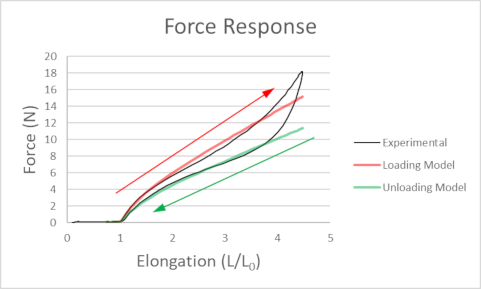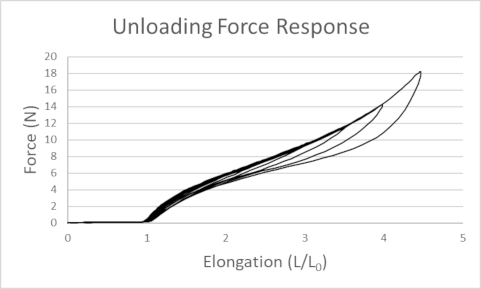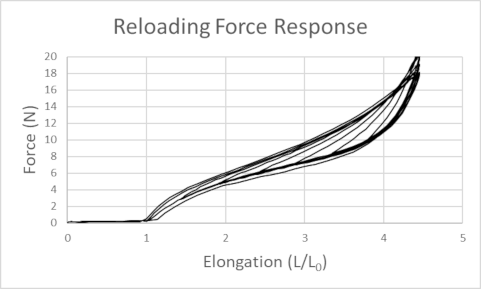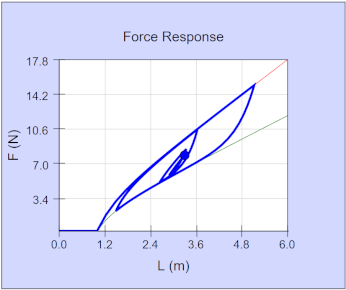Modeling Rubber Band Cords Beyond Hooke's Law
There is a great deal
of fun to be had with scale model "Bungee Jumping" activities using
chains of rubber bands as the bungee cord. Often the
accompanying
discussion simplifies the treatment of the elasticity of the cord,
using Hooke's law as an idealization. On such educational
simulation and accompanying materials can be found at https://www.compadre.org/osp/items/detail.cfm?ID=13284.
Real
rubberbands offer an opportunity to explore topics like non-linear
forces, energy loss and even elastic hysteresis. In the graph
below shows the measured force response of a rubberband slowly
stretched to almost five times its original length (the loading
process) and then allowed to slowly relax to it's original length.
Idealized force models are also shown for both the loading
process (Loading Model) and the unloading process (Unloading Model).
The idealized loading (red) and unloading (green) responses are of the form FL,U(L)=KL,U (L/L0-(L0/L)2), where the two constants KL and KU are for the loading (from completely relaxed) and (asymptotic) unloading from large elongation (L/L0). The force-distance loop is traversed clockwise, and
necessarily
some work was done on the rubber band. This is part of the
mechanism by which the bungee jumper looses energy during successive
bounces, gradually coming to rest.
The
following two experimental graphs show in more detail how a rubberband
can respond to various loading and unloading scenarious. In
the first graph below the band is loaded (stretched) to different
levels and then allowed to completely relax (the band is compeltely
unloaded) from , providing some insight into the band's general unloading
force response. In the second graph the band was stretched
to a set maximum length (for this series), then was partially unloaded
before being reloaded to the maximum elongation, providing insight into
the band's general reloading force response.
The simulation assumes that the force response will always fall between
the idealized loading and unloading models. If the band is in
a given force/elongation state and is unloaded, the
response should parallel the family of curves in the Unloading Force
Response graph. If the band is in a given force/elongation
state and is loaded, the
response should parallel the family of curves in the Reloading Force
Response graph.
To mimic the behaviour for an unloading process from a set
force/elongation state Fi, Li
the force excess above the idealized unloading model is modeled by a
power law. Similarly, for the behaviour for a loading
process from a set
force/elongation state Fi, Li the force deficit below the idealized loading model is also modeled by a power law. Both models can be written (choosing ± for the loading vs. unloading processes):
F(L,Li,Fi) = FU,L(L) +(Fi- FU,L(Li))|(L-L0)/(Li-L0)|pU,L
For loading, pL = -2, so that the force deficit from the idealized model decreases rapidly for increasing length L, while pU
= 10 so that the force excess decreases very rapidly for decreasing
length L. The firure below shows for force history for a "jump"
where the weiight of the "jumper" stretched the cord to a maximum
length of approximately 5 times the unstretched lenght of the band.




